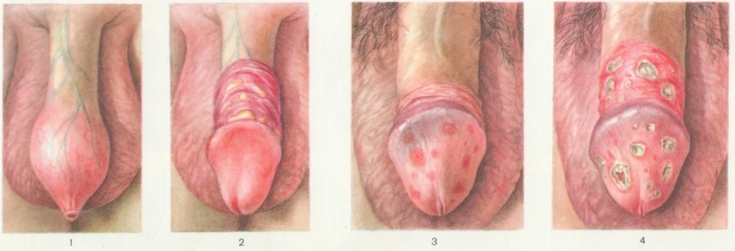Balanoposthitis — This is a disease of infectious etiology, which is characterized by damage to the glans penis with involvement in the pathological process of the inner layer of the foreskin. Most often, balanoposthitis develops against the background of other diseases that reduce the immunological reactivity of the skin, such as diabetes mellitus, anemia and allergic processes. Also, the spread of infection contributes to the violation of hygiene rules and traumatization of the glans penis. Read more about the clinical course of balanoposthitis and methods of its treatment on estet-portal.com in this article.
The main forms of the clinical course of balanoposthitis
Balanoposthitis has several forms of flow: catarrhal, erosive and gangrenous. The simple catarrhal form is characterized by the development of inflammation and maceration of the skin. The erosive form of the flow is accompanied by more pronounced edema, as well as the formation of small erosions on the inner surface of the foreskin and skin of the glans penis. This form is also characterized by the addition of lymphangitis and lymphadenitis.
It is imperative to conduct a differential diagnosis of balanoposthitis and syphilis.
The gangrenous form has the most severe course, accompanied by fever and the formation of deep necrotic ulcers on the head of the penis.
Balanoposthitis:
• clinical picture characteristic of different stages balanoposthitis;
• balanoposthitis: effective methods of treating the disease;
• the main complications that can develop with balanoposthitis.
Clinical picture characteristic of different stages balanoposthitis
Since balanoposthitis — This is an inflammatory disease, it is accompanied by swelling, redness and itching of the affected area. With balanoposthitis, erosions and ulcers can occur on the skin of the penis. Also, the disease can manifest soreness with & nbsp; urination and dyspareunia. In more advanced cases of balanoposthitis, discharge from the urethra may appear, which initially have a mucous character, and in the absence of treatment - & nbsp; become purulent. Also, balanoposthitis is characterized by symptoms & nbsp; intoxication.

Balanoposthitis: effective methods of treating the disease
Balanoposthitis has an infectious etiology, so its treatment will depend on the type of pathogen. With bacterial balanoposthitis, antibiotics are prescribed for local and systemic use. If the disease is of fungal origin — recommended antimycotic drugs. Allergic balanoposthitis requires the appointment of topical steroids and antihistamines. In the event of complications, there may be a need for surgical intervention, for example, in case of paraphimosis, a dissection of the foreskin is performed, followed by its removal during remission.
The main complications that can develop with balanoposthitis
If left untreated, balanoposthitis becomes chronic and often recurs. This disease threatens with deterioration and / or loss of sexual function, due to & nbsp; atrophy of receptors on the head of the penis.
If left untreated, balanoposthitis tends to spread to the organs of the genitourinary system.
Balanoposthitis may be complicated by development paraphimosis. In this condition, the glans penis is clamped by the foreskin. Paraphimosis is accompanied by significant pain and requires immediate surgical intervention to prevent necrosis of the glans penis.
Read also: Treatment of ureaplasmosis in men: all the features of therapy






Add a comment